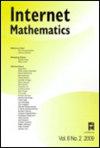KeyPathwayMiner: Detecting Case-Specific Biological Pathways Using Expression Data
Q3 Mathematics
引用次数: 55
Abstract
Abstract Recent advances in systems biology have provided us with massive amounts of pathway data that describe the interplay of genes and their products. The resulting biological networks can be modeled as graphs. By means of “omics” technologies, such as microarrays, the activity of genes and proteins can be measured. Here, data from microarray experiments is integrated with the network data to gain deeper insights into gene expression. We introduce KeyPathwayMiner, a method that enables the extraction and visualization of interesting subpathways given the results of a series of gene expression studies. We aim to detect highly connected subnetworks in which most genes or proteins show similar patterns of expression. Specifically, given network and gene expression data, KeyPathwayMiner identifies those maximal subgraphs where all but k nodes of the subnetwork are expressed similarly in all but l cases in the gene expression data. Since identifying these subgraphs is computationally intensive, we developed a heuristic algorithm based on Ant Colony Optimization. We implemented KeyPathwayMiner as a plug-in for Cytoscape. Our computational model is related to a strategy presented by Ulitsky et al. in 2008. Consequently, we used the same data sets for evaluation. KeyPathwayMiner is available online at http://keypathwayminer.mpi-inf.mpg.de .KeyPathwayMiner:使用表达数据检测特定病例的生物学途径
系统生物学的最新进展为我们提供了大量描述基因及其产物相互作用的途径数据。由此产生的生物网络可以建模为图形。通过“组学”技术,如微阵列,可以测量基因和蛋白质的活性。在这里,来自微阵列实验的数据与网络数据相结合,以更深入地了解基因表达。我们介绍了KeyPathwayMiner,这是一种方法,可以根据一系列基因表达研究的结果提取和可视化有趣的子通路。我们的目标是检测高度连接的子网络,其中大多数基因或蛋白质表现出相似的表达模式。具体来说,给定网络和基因表达数据,KeyPathwayMiner识别出那些最大的子图,在这些子图中,除了k个节点外,子网络的所有节点在基因表达数据中的所有情况下都是相似的。由于识别这些子图的计算量很大,我们开发了一种基于蚁群优化的启发式算法。我们将KeyPathwayMiner作为Cytoscape的插件来实现。我们的计算模型与Ulitsky等人在2008年提出的策略有关。因此,我们使用相同的数据集进行评估。KeyPathwayMiner可在线访问http://keypathwayminer.mpi-inf.mpg.de。
本文章由计算机程序翻译,如有差异,请以英文原文为准。
求助全文
约1分钟内获得全文
求助全文

 求助内容:
求助内容: 应助结果提醒方式:
应助结果提醒方式:


